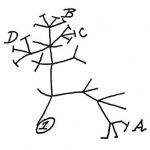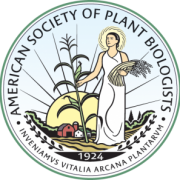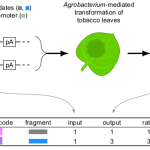Essays on “What makes a paper *really* pioneering?”
What makes a paper *really* pioneering?
This is the question we posed in a recent webinar.
We asked each of our panelists to write a few words on this question, each focusing on a slightly different angle. In the recorded video (below), you can hear the panelists elaborate on these ideas. Here are their written responses.
Lei Lei, Senior Editor, Nature Plants
 What makes a paper really pioneering? Obviously, I can’t have a perfect judgement on this. I am here to share some of my thoughts. A pioneering paper must be based on pioneering research that is rigorous and exciting enough to change how other people think about a scientific issue. In Nature Plants, we have three main criteria when assessing a paper: novelty, general interest, and solidity. In this workshop, the novelty aspects will be elaborated on by several other panelists in a moment. I am going to talk about the solidity and general interest of a paper that make it really pioneering.
What makes a paper really pioneering? Obviously, I can’t have a perfect judgement on this. I am here to share some of my thoughts. A pioneering paper must be based on pioneering research that is rigorous and exciting enough to change how other people think about a scientific issue. In Nature Plants, we have three main criteria when assessing a paper: novelty, general interest, and solidity. In this workshop, the novelty aspects will be elaborated on by several other panelists in a moment. I am going to talk about the solidity and general interest of a paper that make it really pioneering.
Most solid papers are not pioneering, but all pioneering papers must be solid. We cannot assume every publication is sound and reliable. A recent attempt to reproduce 21 social science results reported in Science and Nature were able to reproduce only 62% of the findings (https://www.nature.com/articles/d41586-018-06075-z). And it was suggested that life science papers have an even lower rate of reproducibility (rates vary in different subareas). Some of you may already notice that many novel papers suffer from overinterpretation and other mistakes. Mistakes happen in scientific research just as in any other profession. Honest errors are not big problems. They are subject to queries and rectification. Also, we cannot ignore some serious problems, like fabrication, falsification, and plagiarism. We may still remember the case of Olivier Voinnet, who studied RNA biology in plants. He has published more than 200 peer-reviewed papers and over a dozen with 1,000+ citations. Until 2019, 8 papers were retracted, 5 others received an expression of concerns, and 25 others have been corrected. These papers are definitely not pioneering, although some of them were once considered to be pioneering. We may also recall the research history of Auxin Binding Protein 1 (ABP1), whose mutants, including T-DNA knockout, were studied for more than 20 years, with hundreds of papers published by many groups. The function of ABP1 was believed to be essential in plants until 2015 when CRISPR/Cas9 was introduced to generate a knockout mutant of ABP1 that showed no detectable difference from the Arabidopsis wild-type control. Of course, bringing up these cases again is not trying to scare any of you, but I want to remind all of us that scientific rigor and reproducibility are the foundation of a pioneering paper. Let us all recognize that papers are not only a list on our resumé. They are the main components of scientific record, and reliability is the key of any record.
I may have spent too long talking about solidity or reproducibility. Another point I would like to cover is the general interest of a paper. One of the key criteria for editors like me to think about the impact of a paper is how many other researchers will do their research differently as a result of this work. It is actually a prediction, and predictions are not always right. I am very lucky to be surrounded by a remarkable editorial team. My team’s members have different expertise but broad interest and strong enthusiasm in plant science. Many times, we act as representatives from different subareas of plant research, and if all or the majority of us likes one paper, it probably has some kind of general interest. Our consideration is not only how many people would like to see this paper at this moment but also how many want to check it and benefit from it in the future. Pioneering papers may or may not have immediate impact, but their impact must be long-lasting and expanding. One well-known case is the discovery of transposon by Barbara McClintock. The discovery was made in maize in the 1940s and 1950s, but it was not well recognized until the 1970s, when many other scientists confirmed the mechanisms that she found in maize applying to other systems. Because of this pioneering work, Barbara McClintock was awarded the Nobel Prize in Physiology or Medicine in 1983. Sometimes, a really pioneering work or paper needs years or decades to be understood and recognized. I hope we will have the wisdom to make precise predictions; right now, what we can do is to keep predicting.
Arren Bar-Evens, Max Planck Institute of Molecular Plant Physiology
 For me, really pioneering studies always raise a question: Why didn’t I think of that myself?
For me, really pioneering studies always raise a question: Why didn’t I think of that myself?
This rather simple question actually hides many aspects.
First, if I ask why I didn’t think of that myself, it means that I am already an expert in the field. I argue that it is mandatory to be an expert in a field to identify a truly pioneering study. Otherwise, you might think that you identified such a groundbreaking story, but, in fact, you might have been fooled by pompous words and a high impact factor.
Second, if I ask why I didn’t think of that myself, a study must hold some unforeseeable aspect, which is not a direct logical step from past knowledge and experiments. This aspect could be related to a methodology not used before, an experiment not previously suggested, a new unifying theory, or simply results that are unexpected.
And yet, despite the unforeseeable aspects of a study, it should be simple enough such that I could truly ask why I didn’t think of that myself. I want to argue that most really pioneering studies are simple enough to be understood almost immediately by people from the field and, hence, raise the feeling that they could have thought of it themselves.
I want to give one such example from my field of synthetic biology, or more precisely, synthetic metabolism. When I read, more than a decade ago, the first study that described the introduction of a synthetic photorespiration route to a plant to boost carbon fixation rate and photosynthetic yield, the first thought of came into my mind was: “Why didn’t I think of that myself?”
I was already an expert enough in the field of cellular metabolism and metabolic engineering that I could realize that this work is truly pioneering. It was unforeseeable in the sense that no one has previously thought of using synthetic metabolism to redesign this key process. In retrospect, it is so “simple” conceptually that I really could not understand why I did not think of it myself. After all, applying metabolic design principles to suggest, analyze, and implement alternative pathways to re-assimilate glycolate into the Calvin cycle is quite straightforward, once you think of it.
As expected from a really pioneering study, this first work on re-routing plant photorespiration has led many others, including myself, to peruse such an approach, such that now one can find multiple fascinating stories about different pathways tested to enable more efficient glycolate metabolism and, thus, support higher carbon fixation rate. I guess that many who read the first study have asked themselves: “Why didn’t I think of that myself?”
Magda Julkowska, Boyce Thompson Institute
 Data analysis is where the magic happens for many scientific works. In the truly pioneering works, this magic provides us with new perspectives, allowing us to forge collected data into knowledge. Today, with the exponentially growing amount of data, there is no one way to explore it. The simple, yet unique at that time, approach to data analysis, was performed by John Snow during the cholera outbreak in London in the early 20th century. He combined the numbers of cholera cases with the spatial information, identifying the outbreak hotspots. Modern sequencing technology enabled high-resolution genetic sequencing at a massive scale. This abundant genetic information allows us to connect the genetic loci with a diverse range of phenotypes, spanning from development and disease susceptibility to the ability to be entrepreneurial. The science of comparative genomics was born, which allowed comparing the species genomes and transcriptomes, providing new light on how particular genes, gene networks, and traits evolved. Although the temptation to find certain associations can be very appealing, the data analysis performed without understanding the data or methods can mislead us. Therefore, proper annotation and contextualization of the datasets combined into one analysis are essential. The other type of big data analysis includes a combination of plant anatomy and biophysics, allowing us to develop mode sophisticated models for, e.g., water uptake. These new hypotheses allow us to study the functioning of the world from a new perspective and a new take on designing the experiments. The computational and statistical tools required for these novel data approaches are constantly evolving (Blei and Smyth, 2017) and require more expert knowledge for interpretation. It is important to remember that these large data analysis approaches are exploratory in nature, generating new hypotheses, which require additional experimental validation. Reference: Blei, D. M., and Padhraic Smyth. (2017) Science and data science. Proc. Natl. Acad. Sci USA 114: 8689–8692.
Data analysis is where the magic happens for many scientific works. In the truly pioneering works, this magic provides us with new perspectives, allowing us to forge collected data into knowledge. Today, with the exponentially growing amount of data, there is no one way to explore it. The simple, yet unique at that time, approach to data analysis, was performed by John Snow during the cholera outbreak in London in the early 20th century. He combined the numbers of cholera cases with the spatial information, identifying the outbreak hotspots. Modern sequencing technology enabled high-resolution genetic sequencing at a massive scale. This abundant genetic information allows us to connect the genetic loci with a diverse range of phenotypes, spanning from development and disease susceptibility to the ability to be entrepreneurial. The science of comparative genomics was born, which allowed comparing the species genomes and transcriptomes, providing new light on how particular genes, gene networks, and traits evolved. Although the temptation to find certain associations can be very appealing, the data analysis performed without understanding the data or methods can mislead us. Therefore, proper annotation and contextualization of the datasets combined into one analysis are essential. The other type of big data analysis includes a combination of plant anatomy and biophysics, allowing us to develop mode sophisticated models for, e.g., water uptake. These new hypotheses allow us to study the functioning of the world from a new perspective and a new take on designing the experiments. The computational and statistical tools required for these novel data approaches are constantly evolving (Blei and Smyth, 2017) and require more expert knowledge for interpretation. It is important to remember that these large data analysis approaches are exploratory in nature, generating new hypotheses, which require additional experimental validation. Reference: Blei, D. M., and Padhraic Smyth. (2017) Science and data science. Proc. Natl. Acad. Sci USA 114: 8689–8692.
Scott Hayes, Wageningen University

Many of you listening have likely heard the expression “standing on the shoulders of giants.” It’s a popular cliché for describing the scientific process that nods at the incremental nature of science. It suggests that all advances are simply tiny extensions on the massive existing body of work. Although I think there is some truth to this, for me a better metaphor for the scientific process is building a house of cards. In this metaphor, we can imagine that we have a house of cards representing the scientific knowledge about any given field. As we build levels of this pyramid, each pair of cards leaned together represents an individual study. These individual studies are inherently unstable; some will fall, but others will remain standing.
For me, some of the most important papers in science are those that span the gaps between studies. We can think of these as the cards that bridge between individual triangles and bring stability to the overall structure of our pyramid. What’s more, these cards then serve as the basis for the next layer of studies, and enable us to push our scientific understanding onwards and upwards.
Very rarely we also see an additional kind of study. This kind of study bridges, not between concepts within a field, but between concepts from entirely separate fields. In our metaphor, we can imagine a card spanning the gap from one pyramid to a completely separate one. When this happens, the bridging card has the ability to become the basis for a completely new pyramid, and a new scientific discipline is born.
For me, nothing exemplifies this better than the birth of molecular biology. In one of the founding studies of molecular biology, physics, genetics, and crystallography were combined to determine the structure of DNA. I would argue that the ground-breaking insights of this paper would not be possible without willingness to look outside of a single field. A recurring theme in paradigm-shifting papers is that they draw their inspiration from multiple sources. Incremental studies are of course often the source of this inspiration, but for me it is the studies that link multiple fields of knowledge that are truly pioneering.
Elisa Dell’Aglio, INRA (National Institute of Research Agronomy)
 What is the importance of “missing pieces” in science? Obviously, to recognize it, you need first to have the rest of the jigsaw, or at least enough of it to spot what is missing. In chemistry, the most famous jigsaw is the periodic table, invented in the 19th century by Mendeleev, and that immediately showed two potentials: the one of putting some order in all the known elements, on the basis of their proton number, and the one of predicting the existence of undiscovered elements with predictable reactivity. Nevertheless, when radioactive elements were discovered or synthetized, that was the start of a new era for human history, made of new energy resources, war, and medical advancement.
What is the importance of “missing pieces” in science? Obviously, to recognize it, you need first to have the rest of the jigsaw, or at least enough of it to spot what is missing. In chemistry, the most famous jigsaw is the periodic table, invented in the 19th century by Mendeleev, and that immediately showed two potentials: the one of putting some order in all the known elements, on the basis of their proton number, and the one of predicting the existence of undiscovered elements with predictable reactivity. Nevertheless, when radioactive elements were discovered or synthetized, that was the start of a new era for human history, made of new energy resources, war, and medical advancement.
It’s a bit the same feeling that we perceived when, in 2012, the CERN announced the discovery of the Higgs boson, a long-sought particle that was hypothesized for the first time in 1964 by Peter Higgs. Ok, Peter, you were right, thank you very much you nerd! And so what? Well, now we can finally explain the force of gravity and attempt new predictions on the destiny of the universe.
I guess it is all quite clear now, right? But what about plants? This information may all seem quite abstract for a plant biologist. After all, biology never had a periodic table or a standard model, nothing like a frame to add pieces. But I believe that the concept applies here as well. If we think about the history of life as our standard model and of species as the pieces of this puzzle, then it all starts to make sense. Adding a missing piece in biology can be the discovery of a new or ancient species, the creation of a new species in the lab, and even of a molecular mechanism that helps us to connect the dots. Let me give you an example.
Charles Darwin use to say that the origin of flowers is an “abominable mystery” of evolution, an invention so recent and so successful, but apparently so complex to achieve. Now, thanks to a remarkable comparative molecular biology work, we know that the gymnosperm Welwitschia mirabilis makes rudimental flowers, too, with sterile ovules as well. And this cascade of transcriptional activation equivalent to the one of angiosperms suggests that all the elements needed to construct the flower apparatus were already present in the common ancestor of angiosperms and gymnosperms, ready to bloom and surprise us with amazing colors and shapes (Moyroud et al., 2017). Another piece found its place in the jigsaw of life. Reference: Moyroud, E., Monniaux, M., Thévenon, E., Dumas, R., Scutt, C. P., Frohlich, M. W., and Parcy, F. (2017). A link between LEAFY and B‐gene homologues in Welwitschia mirabilis sheds light on ancestral mechanisms prefiguring floral development. New Phytol. 216: 469-481
Andrew Hanson, University of Florida
 Really pioneering work will be in some sense beautiful. I’ll try to justify this statement.
Really pioneering work will be in some sense beautiful. I’ll try to justify this statement.
Philosophy calls Truth, Beauty, and Goodness transcendentals (“rising above”) because they’re the highest values of human life. The transcendentals are deeply unified: where there’s truth, there’s also beauty and goodness. Notice that all of them can be hard to define objectively so that recognizing them often means making subjective, emotionally based value judgments: the “I know it when I see it” principle.
In what sense, then, can an advance in science – which so aspires to be objective and rational – be said to be “beautiful” if recognizing beauty is a subjective process involving emotion? Here are two classical answers.
First, science that alters how we think about reality – even just small parts of reality – is emphatically not an objective, mechanical business. Everyday science is objective, mechanical, and incremental – it logically follows prevailing paradigms and well-blazed methodological trails. Pioneering science is utterly different; it makes leaps of creative imagination that can come before experimental work, not after it, and that demand profound understanding of, commitment to, even passion for, a field. Note the words “creative,” “imagination,” “commitment,” and “passion.” All are from the vocabulary of emotion. If doing pioneering science in the first place harnesses the emotions, should recognizing it do anything less? Exhilaration and delight are totally fitting – and arguably necessary – responses to an encounter with genuinely pioneering science.
Second, as said above, beauty can’t be separated from truth. So what is true – and with the idea of “truth” we’re in scientists’ “objectivity comfort zone” – is necessarily beautiful in a certain way. But we can be more specific. In fields beyond science, concepts of beauty embrace simplicity, symmetry, harmony, elegance, and power, and aspire to universality and timelessness. Exactly the same is true of the concept of beauty in science.
Lastly, I’m going to add a personal and perhaps controversial view. It goes back to the transcendental that we haven’t invoked yet – goodness. To some degree, what is good can be equated with what is useful, to humans particularly (but not exclusively). So, for me, pioneering science that has potential utility becomes more beautiful. That’s partly why I see synthetic biology (SynBio) as beautiful. SynBio looks back at biology with fresh eyes and says: “It didn’t have to be this way,” i.e. biology took, or was constrained by its past to take, a particular path – but that was happenstance, it could have taken other paths. But SynBio also looks forward in hope and says: “It doesn’t have to be this way in the future” and proceeds to explore solutions that nature has bypassed, distilling out the best ones and applying them to the world’s needs.
Mary Williams, Features Editor, Plant Cell and Plant Physiology

Does storytelling play a role in pioneering science? Yes, and no.
In our scientific lore, storytelling is hugely important, even when it stretches the truth a bit. Newton’s apple demonstrating gravity, Kekulé’s tail-biting snake revealing benzene’s structure, Mendel’s garden segregating in perfect three-to-one ratios, all provide frameworks for our science lessons.
Telling a story is a way of structuring a set of ideas and is as important in presenting a complicated scientific breakthrough as it is in the simple narrative of a fairy tale. Having a brilliant insight and explaining it are two different things, but without the second the first is incomplete. Barbara McClintock was clearly a genius with the ability to see beyond what others could see (comparable to Newton, Einstein, and John Nash) but struggled to convey her insights to others.
 Writers and scientists rely on analogies to help themselves and their readers interpret new information. Sometimes, these analogies start off as images or diagrams. Darwin’s famous sketch shows how he started to imagine organisms changing and diverging from a common ancestor.
Writers and scientists rely on analogies to help themselves and their readers interpret new information. Sometimes, these analogies start off as images or diagrams. Darwin’s famous sketch shows how he started to imagine organisms changing and diverging from a common ancestor.
A good analogy can lead a reader to a breakthrough in understanding: an epiphany or an “aha” moment. I recall this experience when I read Andrew Hanson’s very interesting 2016 review article Metabolite Damage and Metabolite Damage Control in Plants, in which he writes, “Metabolic pathways are thus narrow, well-lit tunnels of known chemistry boring through a huge, dark matrix of unknown chemistry.” Despite decades spent learning about dozens of metabolic pathways, I’d literally never thought of these as just a tiny fraction of the possible space in which metabolism could take place. Reading this article opened my eyes to the true potential of synthetic biology.
My advice is always think of your audience. Successful science depends on sharing your findings, and if you aren’t able to express them clearly to others than you might as well have not done the work. Reference: Hanson, A.D., Henry, C.S., Fiehn, O., de Crécy-Lagard, V. (2016). Metabolite Damage and Metabolite Damage Control in Plants. Annu. Rev. Plant Biol. 67: 131-152.
This webinar is freely available thanks to the support of the American Society of Plant Biologists. Join Today.




